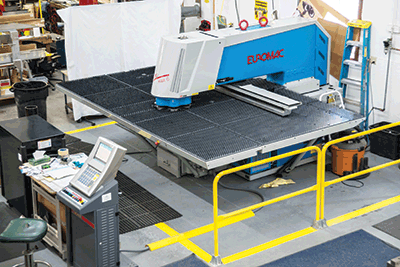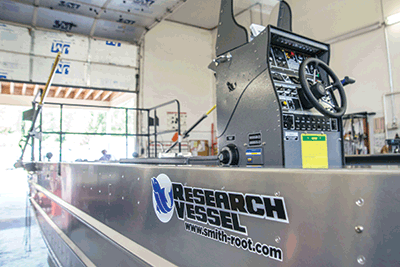 Invest in what you do. That is the mantra of many Southwest Washington manufacturers this year, as they pour significant investments into new facilities, equipment and infrastructure.
Invest in what you do. That is the mantra of many Southwest Washington manufacturers this year, as they pour significant investments into new facilities, equipment and infrastructure.
Take ProTech Composites, for example. This carbon fiber manufacturer grew sales 57 percent last year and projects 30 percent growth this year. Jeff Olsen, ProTech Composites president, said that the company is on track to hit their first million-dollar sales year this year.
With an added employee (bringing the total to seven), ProTech is also adding new equipment and capabilities. In addition to custom flat carbon fiber sheets and panels, customers want high-precision parts with applications including industrial manufacturing assembly, multi-rotor unmanned aerial vehicles and high-end racing engines. Previously, ProTech farmed those jobs out. But with a new, 24” x 24” computer numeric control (CNC) router, ProTech can now create those parts in-house.
“By having that capability, we’ve really expanded what we’re able to offer our customers, and made us a one-stop shop,” said Olsen.
Next week, the company will take delivery of a larger, 4’ x 8’ CNC router that will enable them to cut hundreds of parts out of one setup. The company has also upgraded the controllers for the production tables where they make the carbon fiber, and bought a $9,000 tradeshow booth.
“If we’re going to do it, we wanted to do it right,” said Olsen of the booth. “We wanted it to represent our company well.”
Other investments at ProTech are behind the scenes, such as a complete revamping of the company website.
“98 percent of our business originates from our website,” said vice president Michelle Fennimore. “So it needs to be the best it could be.”
Previously, Fennimore had worked on the website herself. But after talking with a professional website design company that focuses on testing and analytics, she realized that a complete overhaul was necessary.
“Without question it will pay for itself. We could get it back in two or three good orders,” said Fennimore. Next year, she said, they will invest in using more social media and email marketing.
And, added Olsen, the new year will probably also bring a move to a larger facility.
“We’re just starting the last year of a five-year lease, and know we’ll have to move by this time next year,” said Olsen.
US Digital is another example of how local manufacturers are “investing in what they do.” Bob Willoughby, US Digital president, said that over the next six months, they will be making significant investments in new equipment to meet an increasingly sophisticated customer base and growing sales. These investments, said Willoughby, will help US Digital meet today’s needs and those of the future.
Two major areas of investment, he said, were increased software security capabilities to protect intellectual property and customers’ information, and a state-of-the-art flywheel uninterruptible power system (UPS).
“We can’t afford to lose power even for a minute,” stated Willoughby.
Although more expensive than a battery-type UPS, the flywheel model is more reliable and smaller, requires less monitoring and air conditioning, and is not prone to explosions such as is possible with a battery UPS.
While Willoughby acknowledged that the global economy has “lots of flashpoints,” any one of which could negatively affect the market, he said it was important to prepare for a strong market even in the face of risk.
Ben Bagherpour, VP of operations at Vancouver-based SEH America, is “very optimistic about the overall manufacturing market,” after several years of losing manufacturing to overseas.
“We have good opportunities to bring some of that back to the U.S. and here in Vancouver,” said Bagherpour. “To accomplish this we have to be able to compete through an educated workforce and agile/flexible permitting and regulations.”
He said that because the manufacturing market is very dynamic, manufacturers must be able to expand quickly to improve yield, cost and productivity.
“Our economy is growing, people and corporations are spending more, and the engine of the economy is getting going again,” Bagherpour said. “Companies want to expand, and our nation is the most stable for growth and we have all the core materials they need – that is an advantage.” But, he added, politicians must “do their job right” and work with businesses to understand their current and future needs.
At SEH America, said Bagherpour, they are investing money in facilities to make them more energy efficient. For example, in SEH America’s crystal operations, they are modifying the energy-intense crystal pullers. Better insulation helps maintain the heat that melts the crystal, so they use less electricity. They are continuing to hone the solution, but the target is more than 10 percent savings.
In SEH America’s data centers, Bagherpour added, each quarter they invest an allocated amount of money in IT infrastructure to improve internal communication, data collection for thousands of wafers per day and the speed of communication between manufacturing equipment and the data center.
Smith-Root, a manufacturer of fisheries technology, is in the process of building a new 14,000 square-foot facility near Washington State University Vancouver. Projected to be completed in 2015, the new space will replace the company’s current space, spread across three buildings, on Salmon Creek Avenue.
“We’re expanding into new areas,” said Ron Hansen, Smith-Root production manager, “so we have new facility needs.”
Hansen said that the new space will enable the company to do higher quality work at a faster speed, and expand capabilities while allowing for future expansion. Having a single building will enable better communication, said Hansen. And, construction from scratch enables them to create a space that fits their needs.
For example, fish barriers (similar to an underwater electric fence) require a lot of electrical equipment and space to test the product. The new building will feature very few fixed interior walls, creating a versatile space that Hansen said will “serve us well into the future.” Another feature of the new building is a well-plumbed fish lab, tailored to suit the company’s specific needs.
Even before the new facility is finished, however, Smith-Root is also investing in new equipment.
“We buy a piece of equipment every one to two years,” said Hansen. Most recently, they have purchased a CNC punch and brake press. While part of the reason that this type of investment is possible is a recovering economy, Hansen said another driver was the maturation of the CNC equipment market.
20 years ago, he said, CNC equipment was very expensive, and required special facility considerations such as power supply and floor construction. Today, the price for entry-level machines has dropped considerably, and the machines are easy to install and operate.
Hansen said that investing in modern machinery not only enabled Smith-Root to operate more efficiently and create a better product, but it was also an investment in the workforce.
“Our employees get to increase their skill set, and they take ownership of the equipment,” said Hansen. “They are excited about it.”
To support the new machines, Smith-Root is also investing in upgrades to existing 3-D modelling programs as well as purchasing new ones.
“We ask ourselves, ‘Why didn’t we do this sooner?’” said Hansen. “We don’t have a single regret about our investments.”



